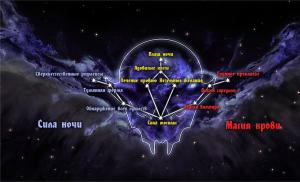Where is the highest temperature recorded. Where is the lowest temperature on our planet?
Let's see what are temperature records in the world and the places where they were recorded. In other words, this compilation 10 hottest and coldest places on Earth.
To begin with, I propose to consider the coldest. These places are reputedly coldest on earth... Brrr - I would not like to live there (:
- Antarctica. Station Vostok.
This station belongs, as you probably already guessed, to the Russians. It was here that the the most cold temperature . A significant date is July 21, 1983, then there was a severe frost, and the thermometer showed record of our planet -89.2 ° C... And now a little more specifically about this place: the height above sea level is 3.5 kilometers, the station is located in the region of one of the largest lakes in the world: Lake Vostok of the same name. Naturally, the lake is not on the surface, it is under the ice at a depth of 4 kilometers.
- Canada. Eureka Station.
This research station is often referred to as coldest locality in the world... -20 ° C is the average annual air temperature, and in winter t usually drops to -40 ° C. This station was conceived as a meteorological station and was created in the middle of the last century.
- Russia. Yakutia. Oymyakon.

Well, this place is already in the North: 350 km from the Arctic Circle to the south. Here has been fixed record for the lowest temperature for the Northern Hemisphere-71.2 ° C (1926). This is confirmed by the memorial plaque installed after this event.
- USA. Denali (Mount McKingley).

This is the highest point in North America. Mount McKingley is the coldest on earth, its height is 6,194 meters.
- Mongolia. Ulan Bator.

And this is already coldest capital... The height above sea level is 1.3 kilometers. The thermometer rarely shows temperatures above -16 ° C in January.
Well, well, we visited the most “icy” places. Personally, I wanted to immediately drink a cup of hot coffee or tea, but this is not at all necessary, because then we will go with you to the hottest countries. Well, let's continue!
So, hottest places in the world.
- Libya. El Aziziyah.

El Aziziyah is just an hour's drive from Mediterranean Sea... Despite this, it is very hot there. For example, on September 13, 1922, there were such sultry days that the thermometer tirelessly showed a mark of 57.8 ° C.
- Africa. Ethiopia. Dallol.

The place is located 116 meters below sea level. And it is in Dallol that record high average temperature air+34.4 ° C. The area is covered with salt and is volcanic in nature, so nothing grows here and nothing is alive at all.
- Libya. Desert Dashti-Lut.

It was in this desert that the most heat on the surface of the Earth +70 ° C... Here it is a record! Here Maximum temperature!! By the way, about the date: they were able to record this temperature 2 times: in 2004 and in 2005. This desert is one of the driest places on the planet. There is also nothing living here, including even bacteria. Imagine: even bacteria won't survive there! But the dunes there are like in a fairy tale: they reach 500 meters in height and are the most beautiful!
- USA. California. Death Valley.

This desert belongs to the second record for highest temperature: +56.7 ° C. The average summer temperature here is approximately +47 ° C. Death Valley is the driest place in the United States, it is surrounded by mountains and is located 86 meters below sea level.
- Thailind. Bangkok.

The average annual temperature in this city is +28 ° C. The hottest here is from March to May - the average temperature in these months is + 34 ° C, and if you also take into account that the humidity is 90%, then this is really all (in vain I drank a cup of hot coffee all do (=).
Let's summarize. We visited amazing places: it was in them that the temperature records, lowest and highest. Personally, I realized for myself: no need for extremes; and it turns out that I am quite satisfied with the climate of the place where I live, it can be cold and hot here, but in comparison with the places listed above, in moderation.
Our Earth is amazingly beautiful. We have the opportunity to enjoy her beauty every day, to use her gifts. But there are places where a person begins to realize how pitiful he is before the greatness of nature. For example - the hottest regions of the planet. Often Earth temperature record people can hardly measure and fix - "bakes" is simply unbearable! So, the hottest journey on planet Earth begins.
The first stop will be. Today this city is a ghost. 1960 to 1966 average annual temperature indicator reached here the value +34,4 ° С, which is a record for today. The heat in Dallol lasts for almost a year. This place is also famous for its hydrothermal springs. In Dallol, located near the Afar Basin, there is constant volcanic activity. The alien landscapes near the volcano look fantastic!
Next, we go to. In the early autumn of 1922, in the Al-Aziziyah region, Earth temperature record - +57,7 ° C. However, it is not officially recognized due to measurement errors. It is also interesting that this place is located near the Mediterranean Sea.
Temperature sets world records and in. The air temperature in the Kebali Desert Oasis is up to +55 ° C.
High temperature indicators were recorded in the United United Arab Emirates... meet you with incredible heat, with air temperature +56 ° C. Rain is very rare here, the level of precipitation never exceeds 3 cm. This desert is very inhospitable.

The state of California in the United States is also ready to compete for the record for the temperature on Earth. acquired the name “Death Valley” for its dry and hot air. This place is recognized by the World Meteorological Organization as the world record holder with the maximum +56,7 ° C. It is surprising that some species of animals live in the "Valley of Death". At night, foxes, lynxes and many rodents crawl out of the holes. The valley becomes very beautiful when it rains. During this period, it is covered with various colors. This is very mysterious place where stones move in an unknown way, leaving traces of their movements.
Talking about temperature records on Earth, Australia is not to be missed. This continent is the driest. Most of it is desert. Temperatures were recorded in the region in 2003 +69,3 ° С on the surface.
Temperatures were also high in Israel. , famous for its unbearable heat. In 1942, a record air temperature for the whole of Asia was recorded here - +53,9 ° C.

is another "hot spot" on our planet. The area is very picturesque - there are spectacular ravines of red sand. NASA satellite measured in mountain system Tien Shan temperature +66,8 ° С on the surface.
The residents of the city suffer from the constant heat. Collections of ancient manuscripts are still kept here. Unfortunately, the elements are making their own adjustments: many streets are covered with sand, huge dunes are formed. The aborigines are haunted by the constant heat. The air temperature here reaches a value +55 ° C. The only salvation for local residents from the unbearable heat is the Niger River, which flows 24 kilometers from the city.

And finally, let's remember. From 2004 to 2009, this desert has established more than one absolute Earth temperature record... In 2005, in the Deshte-Lut desert, the highest temperature indicator on the surface of our planet was measured - +70,7 ° C.
The scalding heat given off by a grill in a restaurant ... damp heat that comes after a summer rainstorm, because of which even just moving becomes uncomfortable ... The air in the car when you left the windows closed, because you were afraid that someone would pull something out of it, enveloping you in heat .. Yes, it may seem like a very high temperature when you experience these phenomena for yourself, but what really high temperatures are, you can find out in our list. At least these are the highest temperatures recorded.
Since Australia's most famous region is the Outback, many assume Australia to be a vast wasteland. In fact, about 70 percent of Australia's area is either desert or semi-desert. V last years Australia also recorded the hottest summer periods... However, the temperature reached its highest point more than 50 years ago, before people knew about the term "global warming" and, accordingly, there was not a lot of noise about this. Temperatures were recorded in the city of Oodnadatta in South Australia. The city of Odnadatta is home to less than 300 people. Considering that record temperature was so high that it killed bed bugs in a matter of seconds, no wonder the population is so small.
8. The highest temperature in Europe
Temperature: 48 ° C
Date: July 10, 1977
Europe as a whole is characterized by a temperate or cold climate. There are no vast deserts here, and even southern countries there is the Atlantic Ocean and the Mediterranean Sea, which keep their weather within reasonable limits. However, in Athens, Greece, temperatures reached an all-time high in the same year that marks the beginning of a heating trend in Europe. Greece is a fairly moderate country, so it was enough unusual phenomenon... Less anomalous was the unconfirmed record in Seville, Spain. Here on August 4, 1881, the temperature allegedly reached 50 ° C, which would put Europe in fact on the level of Australia.
7. The highest temperature in South America

Temperature: 48.88 ° C
Date: December 11, 1905
Unlike Europe, we consider South America to be a hot spot. Extensive rain forests The Amazons seem to be the most likely candidate for the most hot spot... You may have thought that the highest temperature could have been reached in the 105,000 square kilometers Atacama Desert, which is the driest place on the planet, but in fact, temperatures in the desert are moderate. As it turned out, the highest temperatures were recorded in Rivadavia, a city in northern Argentina. Unfortunately, the record high temperature in South America one day did not greatly increase the influx of tourists to this city.
6. The highest temperature in Asia
Temperature: 53.7 ° C
Date: May 26, 2010
Before investigating this topic, we would have thought that the highest temperature in Asia was most likely recorded in the Gobi Desert. But we would be wrong. No, temperatures have not been recorded in either the West Indies or tropical Asia. And not even in the Iranian desert. The hottest city was Multan, the fifth largest city in Pakistan that is prone to frequent flooding. Unlike most of the items on this list, this record was set quite recently and at that time Pakistan suffered from the period extreme heat, from which several dozen people died.
Incidentally, Asia also had the highest surface temperature recorded. The rest of the regional items on the list refer to air temperature. The sand temperature in the Lut Desert was measured in 2005 and recorded as 70.7 ° C. Chicken eggs begin to fry at about 70 ° C, so this is where you could fry an egg on the ground.
5. The highest temperature in Africa
Temperature: 55 ° C
Date: July 7, 1931
There is a surprisingly fierce debate over the warmest temperatures recorded in this part of the world. Until April 2013, the record was held by El Aziza, small town not far from the capital of Libya, Tripoli. The record was a temperature of 57.77 ° C, making it the highest temperature on the planet. But then, after 90 years at the top of the list, the methods used to measure this temperature were revised. As it turned out, the thermometer was located on the ground, so, in fact, it measured the surface temperature, as in the case of the desert in the previous paragraph, instead of the air temperature. After the society of meteorologists recovered from the scandal, the warmest temperature in Africa was brought down to a record set in Kebili, Tunisia. We hope that later it will not turn out that this record was also incorrectly measured!
4. The highest temperature in North America

Temperature: 56.6 ° C
Date: July 10, 1913
Finally, we got to the highest temperature in the entire world. Surprisingly, the phenomenon was reported in the United States of America, not Canada. Moreover, it happened in Death Valley, Nevada. The area is famous for being well below sea level and is likely the driest area in all of North America. It is surprising that someone was sent to check the temperature in those years, given that the weather here is so bad that it regularly approaches a mark that would break the current record. In fact, in 1913, when the record was registered, Death Valley was going through a heat wave that lasted 10 days, in each of which temperatures exceeded 51 degrees. This was in the days when air conditioners were just experimental, so it's hard to imagine how people survived back then.
3. Highest temperature in the oceans
Temperature: 46.4 ° C
Date: 2005
All this talk of near-lethal heat makes you want to plunge into the ocean. On the other hand, these temperatures are quite cool compared to some parts of the ocean. Admittedly, these are small, remote parts of the ocean, but they are there, so it's not worth the risk.
At a depth of three kilometers in the Atlantic Ocean along the Mid-Atlantic Ridge, scientists have discovered volcanic craters that raise the temperature of the water to a point that science had never even thought about. Since then, the water heated to the point where it can melt lead has been called Two Boats and Sisters Peak. The water is so hot and under such pressure that instead of evaporating, it actually blows bubbles up. hot water, which is on the verge of evaporation.
2. Hottest natural temperature
Temperature: 55 555 537.77 ° C
Date: approximately 2000 BC
If you are wondering where or how on Earth the temperature could reach such a mark, the answer is - fortunately, this temperature was very far from the Earth. In fact, it happened very far from Solar system, even on a cosmic scale. The phenomenon took place in a supernova, from the point of view of man on Earth, approximately in the part of the sky known as the constellation Gemini. Supernova left behind a vast cloud of gas known as the Medusa Nebula. When this happened, the supernova reached a temperature 10,000 times the temperature of our Sun.
1. The highest technogenic temperature 
Temperature: 5,499,999,999,726.85 ° C
Date: 13 August 2012
Of course, this unimaginably high temperature was short-lived and limited to a small space, but setting such records is definitely like a sprint, not a marathon. In the famous Large Hadron Collider near Geneva, Switzerland, lead ions (that is, lead atoms, where the number of protons and electrons does not match) were used in experiments with collisions of atoms. The resulting high temperature was caused by a subatomic substance, quark-gluon plasma, which, in theory, the universe consisted of before Big bang... Most importantly, humanity has completely surpassed the highest concentration of heat that the natural universe could create.
It's amazing but the highest temperature in the universe at 10 trillion degrees Celsius was obtained artificially on Earth. An absolute temperature record was set on November 7, 2010 in Switzerland during an experiment at the Large Hadron Collider - LHC (the world's most powerful particle accelerator).
As part of the experiment at the LHC scientists set the task - to obtain a quark-gluon plasma, which filled the Universe in the first moments of its appearance after the Big Bang. To this end, at a speed close to the speed of light, scientists collided beams of lead ions, which have colossal energy. When heavy ions collided, “mini-big explosions” began to appear - dense fiery spheres with such a monstrous temperature. At such temperatures and energies, the nuclei of atoms literally melt and form a "soup" of their constituent quarks and gluons. As a result, in laboratory conditions, a quark-gluon plasma with the highest temperature since the beginning of the Universe was obtained.

Before that, in no experiment scientists have not yet been able to obtain such an incredibly high temperature. For comparison: the temperature of the decay of protons and neutrons is 2 trillion degrees Celsius, the temperature of a neutron star, which forms immediately after a supernova explosion, is 100 billion degrees.
Above the temperature of the stars
According to According to the Morgan-Keenan spectral classification, all stars are divided into the following classes in terms of luminosity, size and temperature:
O - blue giants - 30,000-60000 gr. Kelvin (Vega)
B - blue-white giants 10000-30000 gr. Kelvin (Sirius)
A - white giants 7500-10000 gr. Kelvin (Altair)
F - yellow-white stars 6000-7500 gr. Kelvin (Capella)
G - yellow dwarfs 5000-6000 gr. Kelvin (Sun)
K - orange stars 3500-5000 gr. Kelvin (don't know an example)
M - red giants 2000-3500 gr. Kelvin (Antares)
Our native Sun belongs to yellow dwarfs and has a core temperature of 50 million degrees. Thus, the temperature of the obtained quark-gluon plasma was 200 thousand times higher than the temperature of the Sun's core. At the same time, primordial cold usually reigns in the surrounding space, since the average temperature of the Universe is only 0.7 degrees above absolute zero.
But why do lead ions collide with such high temperatures?
It's all about the charge of the particles. The larger it is, the greater the energy to which the particle is accelerated in the field of the collider. In addition, the ion itself is a fairly large object. Therefore, when such particles collide, and even accelerated to enormous energies, a substance with a fantastic temperature is born.
By the way, they (ions) do not pose any danger, since the amount of superheated matter is very scanty, less than an atom.
Previous record - 4 trillion degrees, established at Brookhaven National Laboratory (USA), lasted only a couple of months. For this, gold ions were collided in the collider. But even then, many scientists predicted that the LHC would surpass this record, because lead ions are much heavier than gold ions.
Received by scientists the record temperature of 10 trillion degrees Celsius lasted only a few milliseconds, but during this time so much interesting data was obtained that it took several years to analyze it. Many measurements were carried out and the data obtained were repeatedly refined and rechecked. After there was confidence that a quark-gluon plasma had been obtained, various indicators were converted into pressure and record temperatures.
During microseconds after the Big Bang, the universe consisted of a similar quark-gluon plasma, which is not an ionized gas, but rather a liquid devoid of viscosity and flowing almost without friction. Subsequently (as it cools down) the quarks combine into neutrons and protons, and already from them nuclei of atoms arise.
What's next?
Physicists are confident that with the help of the LHC they managed to catch the moment before the plasma condensed into hadrons and the moment before the nonequilibrium state between matter and antimatter was created (otherwise our Universe would be filled with only pure energy). Thus, the ongoing research makes it possible to better understand the processes that took place at early stages space development. Ultimately, scientists hope to get even closer to understanding how and why existing matter arose from the mass of a homogeneous quark-gluon "soup"
Emergence such a special state of matter as quark-gluon plasma is a key prediction of quantum chromodynamics. According to her, as scientists manage to recreate the conditions of all earlier moments of the evolution of our Universe, they will see how the so-called strong interaction that holds neutrons and protons inside the atomic nucleus will come to naught.
Now using a detector installed on the LHC ALICE with a mass of 10 thousand tons, scientists will be able to study the conditions that existed in the Universe just a millisecond after the Big Bang that gave rise to it.
It is even difficult to imagine what other discoveries lie ahead for humanity.
This has been noted by specialists for 6 years - since 1960. to 1966 on the volcanic crater Dallol, located in Ethiopia. The temperature at the crater averaged about +34 degrees. But this place is different in that it has been here for almost a year. temperature regime is approximately 34 degrees above zero. The diameter of this is about 1.5 m, and the "Gates of Hell" (as the locals call them) are located above sea level at forty-eight meters.
Stay here long time almost impossible. But nearby there are indigenous people who are not too verbose, and besides, they are also incredibly aggressive.
Highest marks on a thermometer in the 20th century

In 1917, Death Valley in America "delighted" with incredibly high temperatures for forty-three days in a row. Warming up the air reached almost 49 degrees above zero.
For six whole months from 1923 to 1924. in Western Australia, residents lived with an average air temperature of +32 degrees. And the maximum mark on the thermometer was also almost +49 degrees.

The highest temperature in the world was recorded by scientists in 1922. in El-Aziziyah (Libya). The city, in which in the September shade it was +58 above zero, is located above sea level at an altitude of eleven meters. The same temperature mark was on the same day and in Saudi Arabia... That is why both of these places on the planet are recognized as the most.
The highest marks on a thermometer in our century
The Libyan desert Dashti-Lut was incredibly "pleased" with the highest temperature. the thermometers were 70 degrees above zero. In absolutely natural conditions this temperature was recorded only this time and in this place.

At this air temperature, objects become so hot that you can cook food without any tools. For example, on the hood of a car, which simply replaces the stove. And in the shade at this temperature, the air warms up to +60 degrees. Therefore, hardly anyone will want to walk barefoot, and it is simply impossible to do this, otherwise you can get severe burns.
Despite the incredibly high mark on the thermometer, which can be recorded here, a huge number of tourists go to the desert who want to see the half-kilometer-high dunes.
The highest temperature in Russia was recorded in 2010, when there was abnormal heat... In Volgograd and Tambov, the average summer temperature was 41 degrees above zero.
Highest artificially generated temperature

The highest temperature in the universe, created by human hands, is equal to ten trillion degrees. It was this temperature, according to scientists, that accompanied the creation of our Universe. And in our time, we got such an incredible temperature in the Large Hadron Collider in 2010. The scientists managed to see the record mark on the thermometer due to the collision of lead ions, which accelerated to near-light speed.
The highest temperature indicator of the artificial plan was also obtained by the Americans, who experimented on the collision of gold ions. In this test, scientists obtained a temperature that was four trillion degrees.
To understand how high this temperature is, you can simply find out what the temperature of the Sun's core is - and it is equal to fifty million degrees. So we can conclude that the substance obtained by American scientists, which maintains the highest temperature for only a few seconds, has a temperature several tens of times higher than the natural temperature on the solar core.
Highest human temperature

The highest temperature occurs not only in various places on our planet, but also in humans. Temperatures over forty-two degrees are fatal. But in 1980. in one 52-year-old American, the temperature jumped to 46.5 degrees. However, he did not die at all - the doctors successfully cured him and discharged him from the hospital after a 24-day course of treatment.













